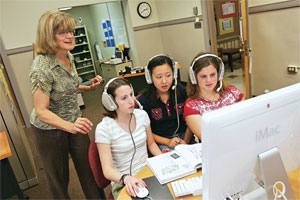New language labs use Internet and video games to improve skills
 Recent renovations to the Foreign Languages and Literatures Resource Center (FLLRC) in rooms 418 and 419 of Pardee Hall have facilitated the development of a collaborative and cooperative learning environment for the teaching of foreign languages.
Recent renovations to the Foreign Languages and Literatures Resource Center (FLLRC) in rooms 418 and 419 of Pardee Hall have facilitated the development of a collaborative and cooperative learning environment for the teaching of foreign languages.
The new, redesigned resource center includes interactive smart boards and slates that facilitate peer editing. The space is furnished with organic-styled tables that allow faculty to move freely among students as they help the latter negotiate and manipulate authentic language materials drawn from the Internet, international television broadcasts, or in-house materials.
A few examples of activities from the spring 2007 semester in the resource center include a business class taught by Michelle Geoffrion-Vinci, associate professor of foreign languages and literature, in which students studied Latin American companies via the Internet. The elementary French class taught by Mary Toulouse, director of FLLRC, held a web conference with students at France’s Ecole Polytechnique about the 2007 French and American presidential campaigns. Also, a class taught by Sidney Donnell, associate professor of foreign languages and literatures, explored the music and culture of contemporary Spain from Pardee Hall.
One of the goals of the resource center has been to create an environment that encourages important informal learning and interaction with faculty, artists-in-residence, international students, and other language students. It is not uncommon to see a student doing homework in a lounge or watching an international program on the plasma-screen television in the Encounter Space.
Although Scrabble and Monopoly are still available, the Sims video game in French, German, and Spanish now has some students dropping by to hone their language skills in their free time. One of the show-stoppers is a state-of-the-art Japanese play station game, Operator’s Side, which is voice activated.
The new center has also hosted a number of art exhibits: the Pasteur Foundation’s 250th anniversary commemoration of the life of Louis Pasteur; an exhibit of medieval art that included student research projects as well as tapestries and posters; an exhibit of images from Colonial Latin America; and the current poster exhibit of art from the period of the Marquis de Lafayette.
The resource center has an important role to play as the department moves forward with its initiative to encourage each student to build a portfolio demonstrating his or her proficiency in the languages studied at Lafayette.
Examples of recent portfolio assignments for students include using the voice-recording software to interpret poetry in an upper-level Spanish class taught by Denise Galarza Sepulveda, assistant professor of foreign languages and literatures; creating photo stories such as Rico Suave, the life of a Puerto Rican boy; and developing multimedia narratives analyzing literary works such as the Heptameron in a French class taught by Olga Anna Duhl, professor of foreign languages and literatures. The center has also been used by students to produce videos of life at Lafayette and professional subtitling of commercial videos for other classes.
 Recent renovations to the Foreign Languages and Literatures Resource Center (FLLRC) in rooms 418 and 419 of Pardee Hall have facilitated the development of a collaborative and cooperative learning environment for the teaching of foreign languages.
Recent renovations to the Foreign Languages and Literatures Resource Center (FLLRC) in rooms 418 and 419 of Pardee Hall have facilitated the development of a collaborative and cooperative learning environment for the teaching of foreign languages.